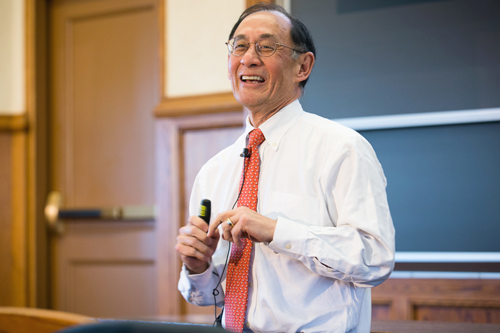This website uses cookies
We use cookies to ensure that we give you the best experience on our website. If you continue to use this site we will assume that you are happy with it.
“You know, it increases the pressure ever so slightly when you’re about to open on the first day [of litigation], and the Wall Street Journal says it’s the ‘Trial of the Century,’” observed William F. Lee, JD ’76, MBA ’76, at the Law School on February 20, as he regaled students and faculty with his account of the Apple-Samsung trial of 2012.

William F. Lee, JD ’76, MBA ’76
Lee is a leading intellectual property litigator who has represented a variety of technology-focused clients for more than thirty-five years. He has tried more than 200 cases to verdict and argued more than seventy-five cases, including some of the highest-profile patent cases of the last decade, to the Court of Appeals of the Federal Circuit and other appellate courts.
Lee’s talk, “The Smartphone Wars,” was presented by the Dean’s Distinguished Lecture Series, launched this academic year. In his introduction for Lee, Eduardo M. Peñalver, Allan R. Tessler Dean and Professor of Law, noted, “He has been an invaluable counselor to the Law School’s leadership, including both my predecessor and myself, providing us with crucial insight into the direction of the legal marketplace and how Cornell can best position itself to continue to succeed in preparing our students for the practice of law in the twenty-first century.”
Lee said that he chose to speak about the Apple-Samsung case, because it demonstrates both the critical role that lawyers play when technologies merge and also the increasingly global scope of intellectual property disputes. In addition to trying the much-scrutinized case between Apple and Samsung in the United States District Court in San Jose, California, Lee also helped coordinate fifty-nine related cases across fourteen jurisdictions around the world.
“Trial of the century” declarations were not the only striking headlines to come out of the case. Media outlets reported “Judge Questions Whether Apple Lawyer Is Smoking Crack” immediately after an exchange between Lee and Judge Lucy Koh, who was incredulous of the Apple team’s proposal to examine sixteen witnesses in three days. This was just one example of the avid media coverage of the trial, which took place in a courtroom jam packed with journalists. “Everybody was online,” said Lee, who was no exception. Upon returning to his seat after the conversation with Koh, he noticed an e-mail from his daughter: “Dad, glad you’re not smoking crack.”
Much of Lee’s lecture addressed how his team told Apple’s story. “We think, as lawyers, about the analytical framework for our cases, the things we have to prove, the evidence we have to demonstrate, and that’s all critically important,” he said. “But equally important, maybe more important if you’re doing a jury trial, is: What’s the narrative? What’s the story around which you build your analytical framework?”
Because Apple was secretive about its development process at the time, the trial provided the media and the public their first glimpse into how the iPhone was created. Lee and his colleagues called witnesses who had been intimately involved in designing and marketing the device. One of their first was design engineer Christopher Stringer. “Now, as was true with many Apple engineers, he didn’t own a suit,” recalls Lee. After the lawyers told him he would have to buy one for his court appearance, Stringer showed up in a white suit with a lavender shirt. The legal team decided it wasn’t worth asking him to try again. Despite the engineer’s unusual appearance, his testimony effectively contributed to, in Lee’s words, “a compelling narrative about the innovations and the inventions and the creativity that led to the iPhone.”
That narrative was punctuated with a video clip of Steve Jobs, who had passed away by the time of the trial, presenting the iPhone at the 2007 Macworld conference. “This allowed us to say, ‘Where were you on January 9, 2007? What do you remember about what phones were like before January 9, 2007?” said Lee.
The Apple legal team presented the jury with enthusiastic responses to the iPhone by the likes of TIME and the New York Times, and even the U.S. Patent Office, which created an exhibit dedicated to the device. The team was also able to present internal documents from Samsung indicating a conscious imitation of the iPhone’s popular features and elements in the development of the Galaxy smartphone.
The jury awarded Apple 1.05 billion dollars in damages for patent infringement by Samsung. Subsequent skirmishes brought the dispute to federal circuit court and ultimately to the U.S. Supreme Court before it was remanded back down the line to the district court of Judge Koh. Years after the trial began, the exact amount of damages owed to Apple by Samsung remains undecided.
In his concluding remarks, Lee noted that the duration of the Apple-Samsung trial highlights the often onerous path to resolution in the U.S. judicial system. Yet it also exemplifies the system’s adaptability. “One of the things I think this [case] demonstrates,” he said, “is that our system is capable of taking these areas where technologies converge and actually articulating a set of principles, based upon 300-year-old law, that can make some sense.”